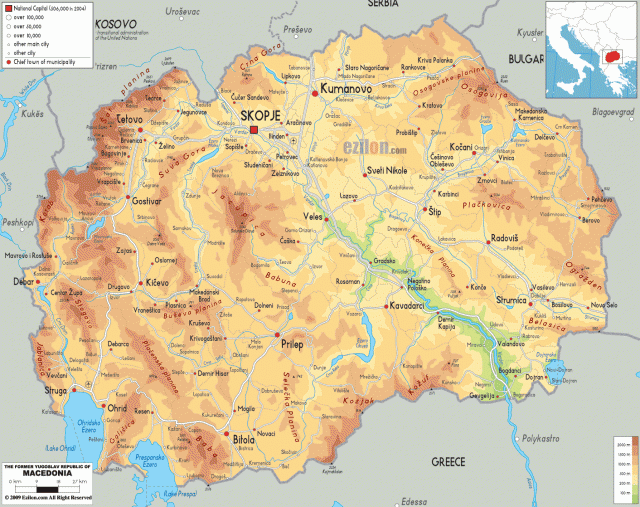Macedonia (FYROM)
Area 9,781 square mi (25,333 square km)
Population 2.076 million 2014
Capital Skopje
Highest Point 9,085 ft (2,753 m)
Lowest Point 165 ft (50 m)
GDP $11.32 billion 2014
Primary Natural Resources chromium, lead, zinc, manganese.
THE REPUBLIC OF Macedonia is a country in the southern Balkans but covers only part of the larger historical and geographical area known as Macedonia. The northern region of GREECE is also known as Macedonia, which has been a source of cultural conflict since the republic declared its independence from Yugoslavia in 1991. Greeks assert that the name “Macedonia” is a specifically Greek term, and not applicable to the Slavic people who today make the region their home. Pending United Nations-moderated negotiations, Greece and most international bodies officially refer to the republic as FYROM, the Former Yugoslav Republic of Macedonia.

Macedonian nationalism, as distinct from other south Slavic peoples is, moreover, a relatively new concept, introduced and encouraged by dictator Josip Tito upon the creation of a separate Macedonian Republic within the Yugoslav Federation in 1946. Prior to this, the area generally known as Vardarska banovina (the district of the Vardar River) was considered simply an extension of its southern Slavic neighbors, either Serbians to the north, or Bulgarians to the east. Slavs arrived in the Balkan Peninsula only in the 6th century, and therefore have nothing to do with the well-known classical kingdom of Macedonia, which dominated the rest of Greece, the Near East, EGYPT, and Persia under Alexander the Great in the 4th century B.C.E. The region was controlled by the Ottoman Turks dating from the 14th century, then contested by Greece, BULGARIA and SERBIA after the First Balkan War of 1912, which immediately led to the Second Balkan War of 1913. The result of this war was a partition of Macedonia between these three powers, the southern half going to Greece, the northern half incorporated into the kingdom of Serbia, and a small eastern portion, called Pirin Macedonia, given to Bulgaria. The Yugoslav Republic of Macedonia was set up after World War II in part to offset the continued claims of Bulgaria on the Vardar valley.
The Vardar River dominates Macedonia, nearly bisecting the country, and providing its chief outlet to the sea. Because Macedonia is LANDLOCKED, its economy relies heavily on transport down the Vardar across northern Greece (where the river is called the Axios) to the major Aegean port city of Thessaloniki. Greece's trade embargo against FYROM from 1994 to 1995 was thus of great significance. Similar international embargoes against Serbia during its wars of ethnic cleansing in the 1990s cut Macedonia off from its largest trading partner.
The economy was strained even further by the flood of more than 350,000 Albanian refugees in 1999, most of whom have today returned to Kosovo. Macedonia had its own ethnic conflict in 2001, when a group of Albanians began an insurgency in the western part of the country, demanding greater rights for the country's Albanian minority. Ethnic Albanians make up roughly 23 percent of the population, chiefly oncentrated in the western part of the country, across the borders from the Republic of ALBANIA and the Serbian province of Kosovo.
Macedonia is almost entirely mountainous; 14 peaks exceed 6,600 ft (2,000 m). The highest are in the western part of the country, running roughly from northwest to southeast. The Sar mountains in the northwest, and the Crna Gora (Black Mountains) form the border with Serbia in the north, while the Osogovo Mountains run along the eastern border with Bulgaria. The southern border with Greece is defined by the Nidze mountains. Most settlements are in the larger river valleys, the Crna, Treska, Pcinja, and Bregalnica, all tributaries of the Vardar. Skopje, the country's capital (population about 500,000), is located on the Vardar River. Other major cities are Tetovo, Kumanovo, Gostivar, Bitola, Ohrid, and Titov Veles.
The climate in Macedonia is a mixture of Mediterranean, continental, and mountain. Crops are therefore varied depending on elevation. Agriculture is dominant but there are also significant industries, including chemicals, steel, and textiles. Macedonia was Yugoslavia's poorest republic, but political and cultural disturbances of the past decade have exacerbated its economic struggles—roughly 40 percent are unemployed—and the area is also prone to earthquakes and drought. Large numbers of NORTH ATLANTIC TREATY ORGANIZATION (NATO), United Nations, and EUROPEAN UNION (EU) troops are stationed in Macedonia (nearly 20,000 in 1999), mostly in relation to peacekeeping missions in neighboring Kosovo, which both stimulates the economy and causes further strain on it.
A change in the flag (dropping Alexander the Great's 16-point Vergina Sun for a simpler eight-point star) in 1995 and a change in the wording of the constitution have allayed Greek fears of south Slavic expansion and allowed for greater recognition in the diplomatic world and economic aid from the EU and the rest of the international community. Macedonia in 2004 was a candidate for membership in both NATO and the EU.